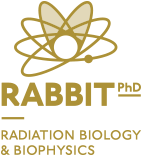






























Technical details
Electron transfer in atom-(bio)molecule collisions
Using a crossed molecular beam technique we are investigating electron transfer processes in collisions of neutral fast potassium atoms with DNA nucleotide bases (adenine, thymine, cytosine and guanine), uracil the comparable RNA base and other relevant biomolecular targets such as sugars (e.g., glycoaldehyde), and radiosensitizers (chloro- and fluoro-uracil).
We investigate the formation of negative ions and hence model the parent anion state. Total partial cross sections are obtained in an energy range from about a few eV up to several hundreds of eV. These experiments will allow us to clarify whether these molecules behave similar or differently from the single free electron attachment experiments in terms of their major reaction products. This in turn will provide information on whether EA by free electrons is correct model for electron transport in DNA or whether EA by bound electrons (as in K molecule scattering) is a more appropriate model for electron transport under physiological conditions.
Electron transfer reaction is a key process in transmission of electrons through the DNA helix and perhaps explains how SSB damage may lead to DSB and thence more complex damage.
Electron transfer in low energy atom-molecule collision is usually mediated by the crossing of the potential energy surfaces, K + AB (covalent) and K+ + AB- (ionic). Despite the fact that the ionic surface lies above the covalent at large atom-molecule distances, due to the Coulomb potential there is a crossing point at which both potential energy surfaces have the same value. This crossing processes leads to the formation of both K+ and a molecular anion and allows access to states which are not accessible in free EA experiments. In particular, states with a positive electron affinity can be formed, and the role of vibrational excitation of the parent neutral molecule can be studied. In this particular case the electron donor is a potassium (K) atom and AB the electron acceptor molecule will be the biomolecule.
For further details contact: Professor Paulo Limao-Vieira
High Resolution Electron Energy Loss Spectroscopy (HREELS)
Further to the fruitful scientific exchange with Prof. Marie-Jeanne Hubin-Franskin from the University of Liège, Belgium, and her endowment to our research group, we are fully operational with a HREELS setup to study the electronic state spectroscopy of molecular targets. Our main scientific scope is to provide a set of data to be used in protocols that make use of Monte Carlo simulation for radiotherapy assessment.
For further details contact: Prof. Filipe Ferreira da Silva
He(I) Photoelectron Spectroscopy (PES)
Further to the fruitful scientific exchange with Prof. Jacques Delwiche from the University of Liège, Belgium, and his endowment to our research group, we are setting up at the moment a He(I) PES to study the lowest lying ionic states of molecular targets. Our main scientific scope is to provide a set of data to complement VUV photoabsorption studies (synchrotron radiation) and HREELS on the electronic state spectroscopy of molecules.
Further technical details will be added soon.
For further details contact: Professor Paulo Limao-Vieira



